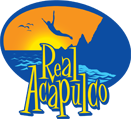Statues
Acapulco has many statues, used mainly as landmarks or points of reference. You should know that a "traffic circle" is called a "glorieta" locally. That's where many of the statues are placed.
La Sirena Costeña (a.k.a. La Sirena Robusta)
Located at the roundabout marking the entrance to the expressway to Zihuatenejo/ Ixtapa, the Mermaid of the Coast (or the Fat Mermaid as she is more popularly known) is Acapulco's newest and most controversial statue. It was donated to the city in 2008 by its creator, local sculptor Samuel Muñúzuri. His stated intention was to create an "Acapulco icon." Instead, the statue immediately drew widespread criticism for its unsightly appearance (some would say it is an outright eyesore) and its perceived slight to the woman of Guerrero. Many felt it was the artist's intention to portray local women as tacky, pretentious, a bit dumb, and rather overweight. The criticism became so intense that Muñúzuri offered to withdraw the work of art for fear of vandalism by his critics. For the moment, the Mermaid remains. Whatever your position might be on the meaning of this work, you will have to agree that the Mermaid has become Acapulco's newest tourist attraction.
Agustín Lara
This statue is found by the glorieta at Playa Caleta. Known as “The Musical Poet,” he was considered the most significant Mexican songwriter in the era before World War II.
Code of Arms of the King of Saudi Arabia
It is located on the Costera in front of the Grand Hotel Acapulco.
José Rizal
This statue, donated by the Filipino Embassy, resides on the Costera at Fernando de Magallanes. Rizal is a national hero in the Philippines. He promoted Philippine independence through peaceful resistance to Spanish colonial rule.
La Diana
The huntress is the most famous lady of Acapulco's traffic circles. It is hard to avoid the Diana glorieta, the busiest intersection in town, just east of the Galería Diana shopping mall, south of the Mega-Mex and Sam’s Club, and west of Condesa Beach. The nightclub scene really starts with Diana. She stands, nude and life size, immortalized in bronze, flexing her bow.
Monument to La Nao of China
The Nao de China Monument is located in La Quebrada. It commemorates La Nao de China, one of the principal galleons in the trade that connected Acapulco with Southern China and the Philippines. “Nao” is an archaic shortening of “Navio” or ship. Every year Acapulco hosts a Festival of the Nao, inviting entertainers from Spain, China and other countries of the Pacific Rim. It occurs around the date of the birthday of Andrés de Urdaneta, a sea captain who lived in Acapulco for a while and who discovered the trade winds that would bear ships back to Mexico from China, thus permitting the lucrative trade.
Mahatma Gandhi
This life-size bronze statue of Gandhi walking with a long walking-stick is also on the Costera at Juan Serrano in Costa Azul. It was donated by the Indian Embassy. Gandhi, a leader of the Indian independence movement, pioneered the non-violent protest. “Mahatma” is an honorific title, meaning “great soul.” Acapulco's Golden Zone is a great setting for this statue, which is meant to symbolize freedom and peace.
Miguel Alemán
Miguel Alemán, for whom the Costera was named, is honored by a statue near La Diana at the glorieta. Miguel Aleman was Mexico’s first civilian president since the time of the revolution, taking office in 1946. During his presidency, and then afterwards as head of Mexico’s Tourism Commission, he worked tirelessly to open up Acapulco to the rest of the country and the world. He was instrumental in connecting all the areas around the bay, in building the Scenic Highway over to Diamante, and in improving road access from Mexico City.
José María Morelos Obelisk
Morelos was a central figure in the struggle for independence from Spain. He came from Valladolid, Michoacán (now renamed "Morelia" in his honor), and led insurgent troops in the south. When he was captured and executed by the Spanish in 1815, his lieutenant, Vicente Guerrero, took over the command. Guerrero’s name was given to the state in which Acapulco is located. The statute is on the Costera Miguel Alemán, downtown at its junction with Calle 5 de Mayo.
Pharaoh Tuthmosis III
Pharaoh Tuthmosis III is a statue donated by the Egyptian embassy of a great monarch from the 15th century BC, who created an enormous Egyptian empire. It is located in front of the Casa de la Cultura.
Rotunda of the Illustrious Men
Rotunda of the Illustrious Men is located at Playa Tlacopanocha, near the downtown pier and the Zócalo. It is a memorial to a select group of the honored and departed.
Sculpture of the Samurai
The statue of the Samurai, donated by the Japanese embassy, is on the Avenida Costera Miguel Alemán at Carabela Santa María.
Simon Bolívar
Simon Bolívar, a hero of independence movements in South America, is found represented in bronze on the Costera Alemán in front of the CICI Water Park in Costa Azul. It was donated by the Embassy of Venezuela. Venezuela, Panama, Colombia, Peru and Bolivia each regard him as their liberator from Spain.

